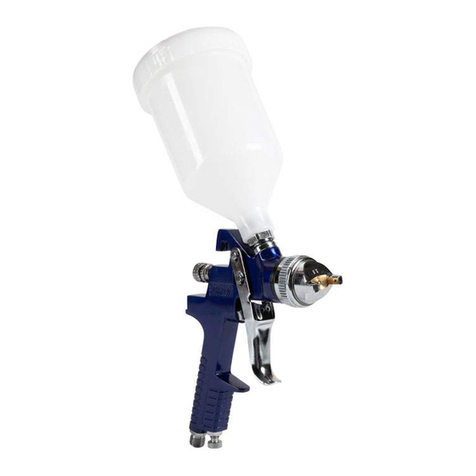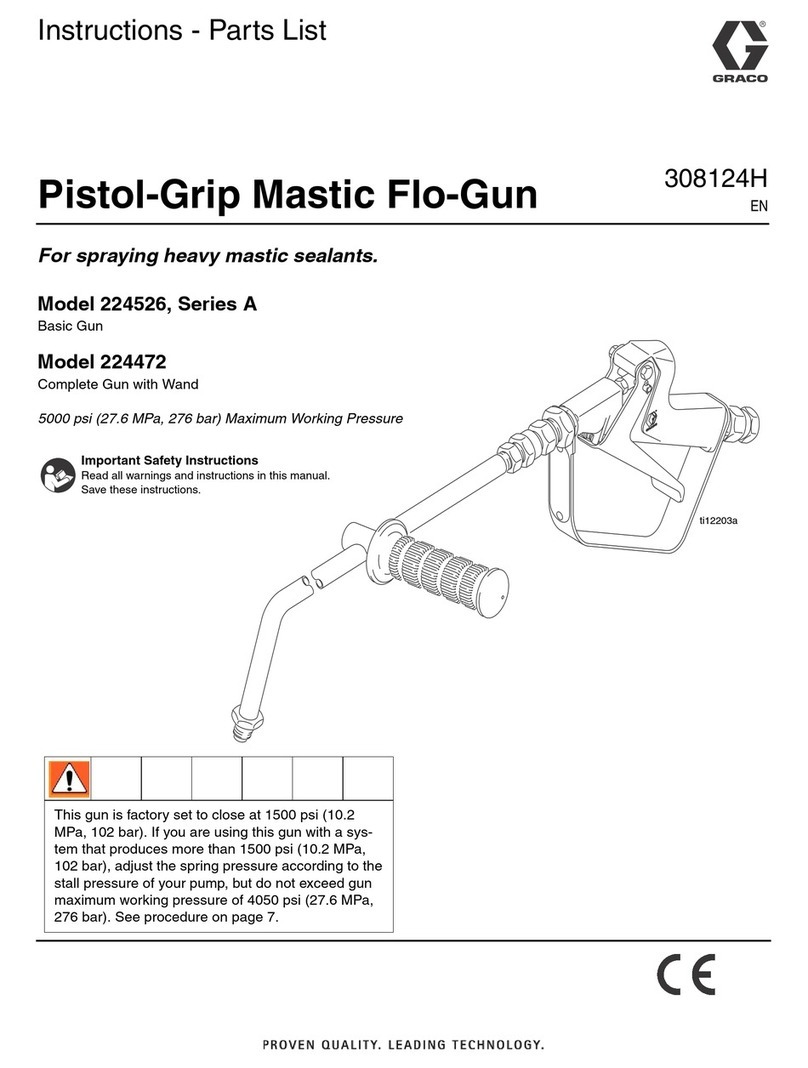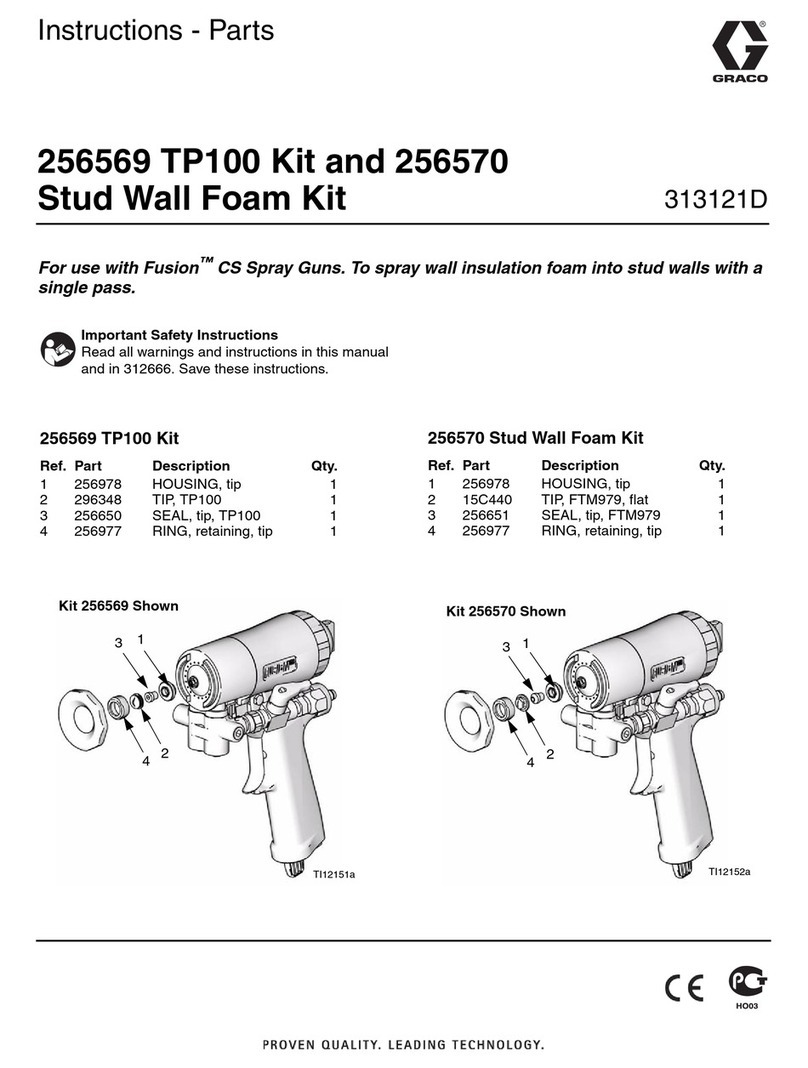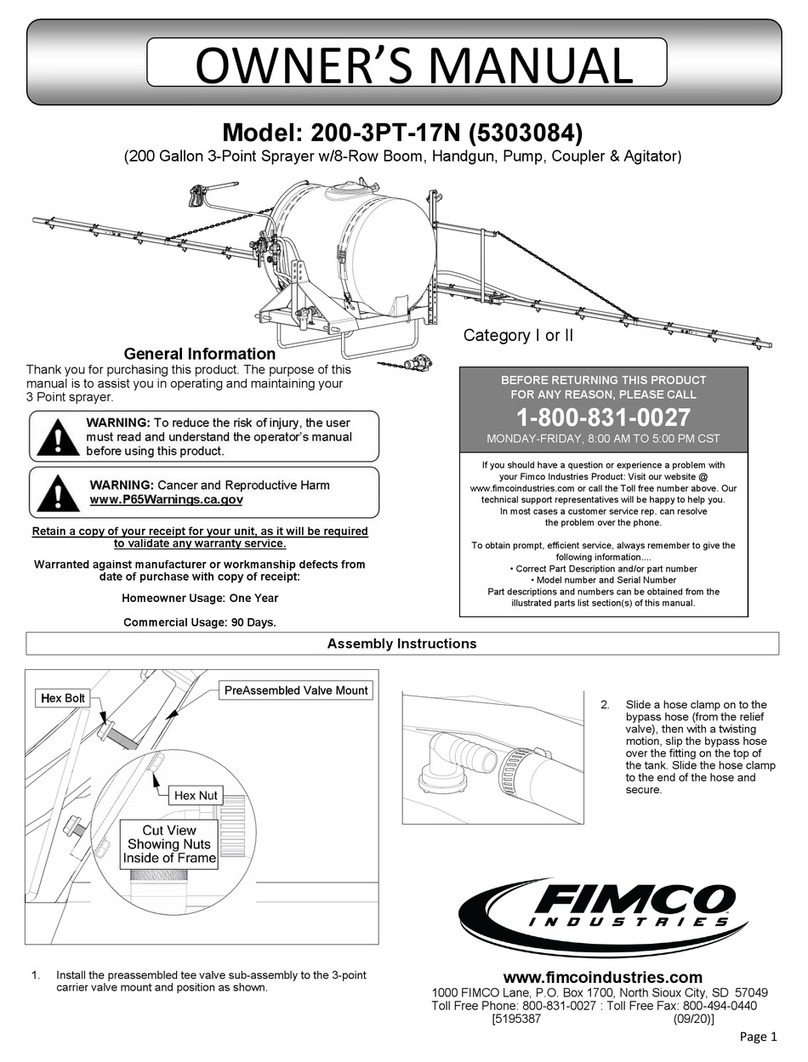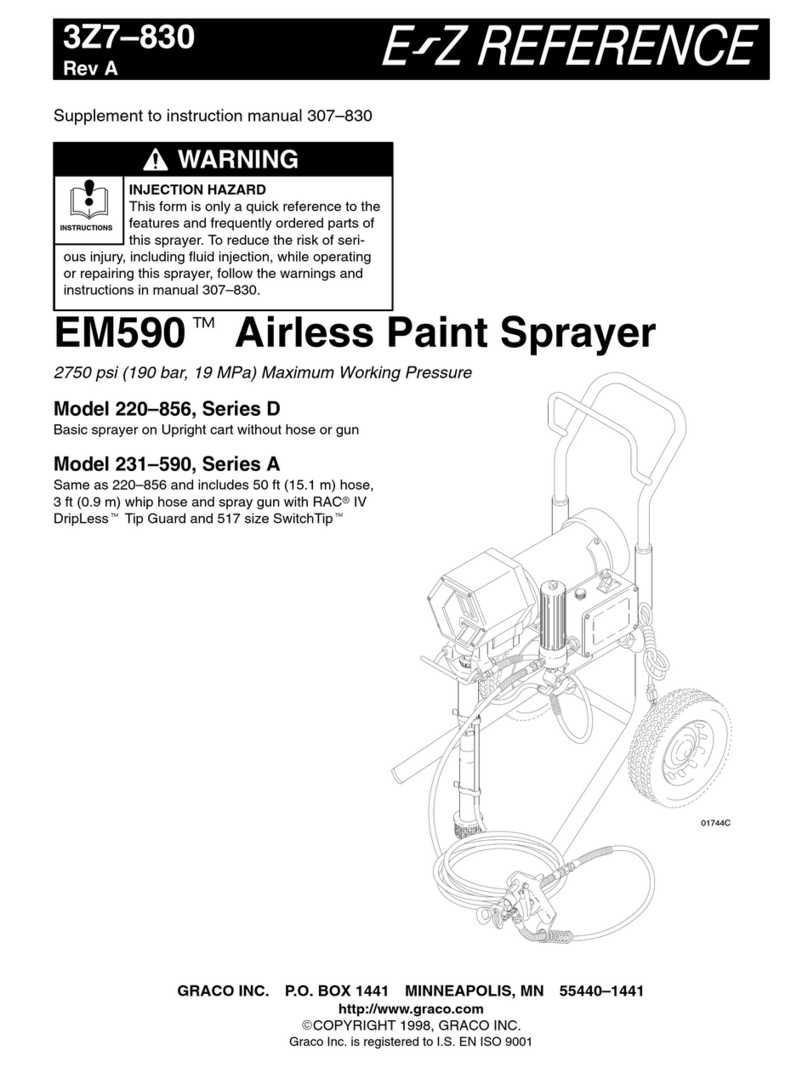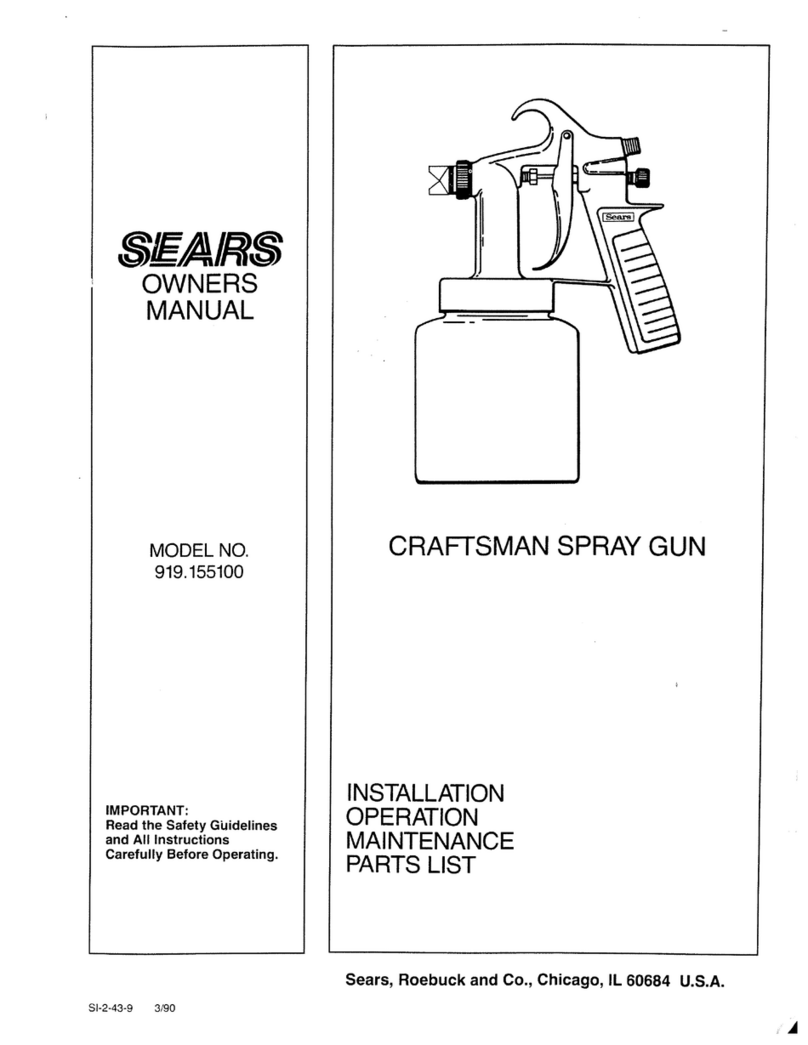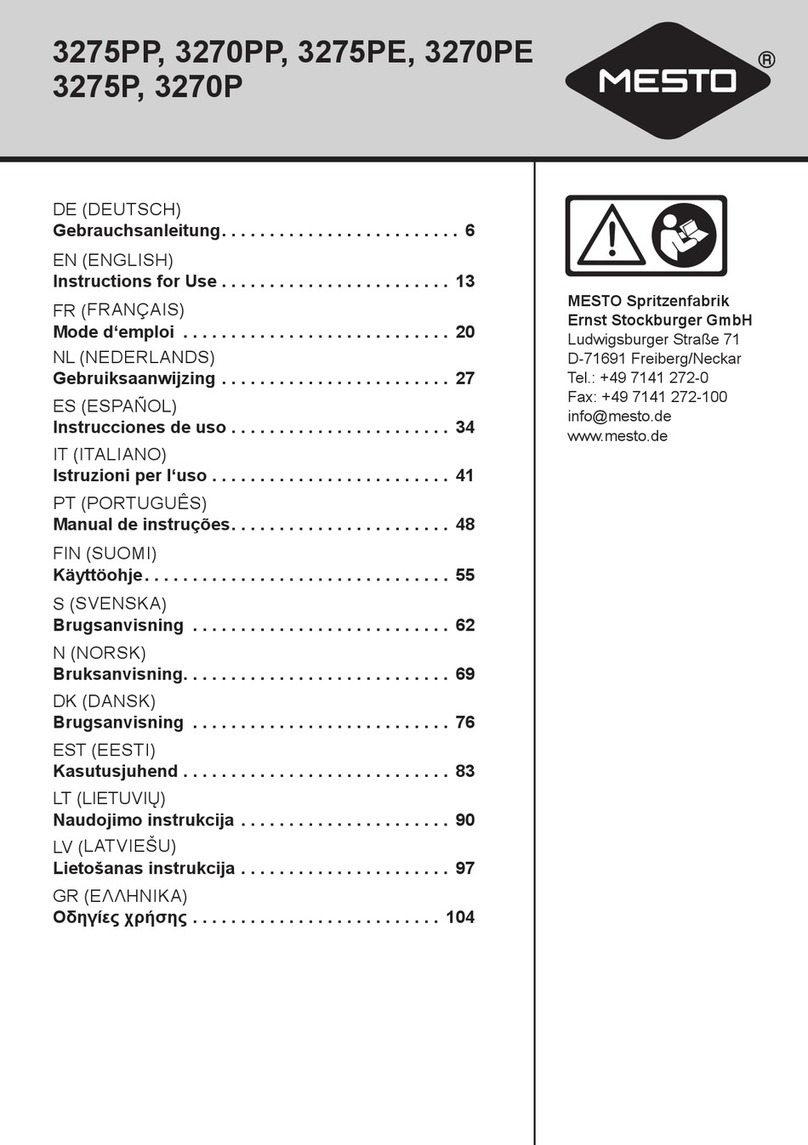Fibre Glast 123-A Parts list manual

385 Carr Drive
Brookville, OH 45309
www.fibreglast.com 1.800.821.3283
PDCT-PI-00008-A-10/07-RR
385 Carr Drive
Brookville, OH 45309
www.fibreglast.com 1.800.821.3283
1/4 Pint
Touch Up Spray Gun
123-A
Usage Instructions & Parts List
GEL COAT TROUBLESHOOTING GUIDE, continued
6. Discoloration On Finished Parts:This problem is caused from porosity
related to air entrapment while spraying.This can be overcome by spraying
the mold surface with several light passes. It is also important to bleed any
moisture from the air lines and to be sure that the mold surface is dry.
7. Craters And Pock Marks:These surface blemishes can be caused by
improper resin to catalyst ratios and improper air pressure both high and low.
Another cause for craters would be oil or moisture on the surface of the mold.
8. Fisheyes: Fisheyes are usually caused by contaminates on the mold like
dirt, moisture or oils. Bleeding the air lines and using air filters will lower any
air related contaminates.Try to isolate the spray area from any oils, especially
silicones.
9.BlistersWhen Immersed InWater:Blisters can be caused for the following reasons:
1. Incomplete cure
2. Improper wetting of the back up fibers
3. Bad bond between the gel coat and the back up laminate.This is
often caused by contamination.
4. Thin gel coat
10. Lifting Of Gel Coat Before Laminating: This condition is usually related to
shrinkage of the gel coat. Shrinkage can be caused by:
1. Too fast of a curing time normally caused by over- catalyzation.
2. Delays between the gel coat and laminating can cause shrinking
3. Variationsingelcoat thicknesscan varythegeltimewhichcancauseshrinkage.
4. The mold surface is too hot.
11. Back Up Pattern Showing Through Gel Coat:This visual pattern is caused
by too low a gel coat thickness or the gel coat was not properly cured.
12. Gel Coat Sticking To The Part:This condition is caused by improper
releasing of the mold surface. It is important to use release agents formulated
for the reinforced plastics industry. Proper training and common sense will
eliminate most of the problems associated with gel coats. Proper handling of
gel coats will result in a part with a blemish free surface.

2 7
Operating Instructions and Suggestions
This portable touch-up gun offers a highly controlled spray pattern for pinpoint
accuracy, reducing wasted gel coat and harmful emissions. Its small size,
minimal air consumption, and easy clean-up makes it the perfect choice for
on-site repairs.
This gun comes fitted with a 2.0mm nozzle, which is ideal for any of our gel
coats. But don’t use it just for repairs; it’s also great for spraying PVA! Ships
complete with 1/4 pint cup, cleaning brush, and 1 mini filter.
Read this Instruction Manual carefully. Basic precautions should be strictly
followed to prevent the damage to the tool and injury to the operator. Retain
this manual for further reference.
Important Safety Instructions:
1. Certain materials can create toxic vapors, intoxication and serious
damage to health. Always wear safety glasses, gloves and respirator
to prevent the toxic vapor hazard, or solvent and gel coat coming into
contact with your eyes or skin.
2. Never use oxygen, combustible or any other bottle gas as a power
source to avoid explosion and serious personal injury.
3. Fluid and solvent can be highly flammable or combustible. Use in
well-ventilated spray booth and avoid any ignition sources, such as
smoking, open flames and sparks.
4. Disconnect tool from air supply when not in use or maintaining also a
shut off valve. As an emergency stop is recommend.
5. Use clean, dry and regulated compressed air rated at 30 - 80 PSI. Never
exceed maximum permissive operating pressure.
6. Never use homogenate hydrocarbon solvent, which can chemically
react with aluminum and zinc parts and chemically compatible with
aluminum and zinc parts.
7. Never point gun at you or others at any time.
8. Before operating the tool, make sure all the screws & caps are securely
tightened in case of leaking.
9. Before spraying, be sure the trigger and related parts operate smoothly.
10. Never modify this tool for any applications. Only use recommended
parts, nozzles and accessories.
GEL COAT TROUBLESHOOTING GUIDE
Proper gel coat application is difficult for professionals and is probably the
most common problem area for those new to fiberglass work. Most common
gel coat problems are related to temperature variation, catalyzation and a
variety of handling techniques.The following list of gel coat problems and
causes should help to resolve some of the difficulties associated with gel coat.
1.Wrinkles And Pinholes: A coating less than five mils thick may wrinkle,
especially when brush marks are present. Check the thickness using a gel coat
thickness gauge.The preferred thickness is .010” to .020”.
A wrinkle can also occur if the gel coat is not cured enough prior to lay-up.
Before lay-up check the surface for tack.The surface should be sticky but not
transfer to your finger. Several things can affect a slow cure; solvent or water
entrapment, under catalyzation, cold temperatures and other factors.
If the gel coat film contains pinholes, check the spray equipment for moisture
in the air lines or dirt in the traps. It is also important to review your spray
techniques.
2. Slow Gel Coat Cure: Any temperature below 70 degrees F will retard the gel
time. An under-catalyzed gel coat will also result in a slow cure but this is not a
recommended technique for deliberately lengthening gel time. High moisture
and humidity will lengthen the gel time.
3. Sagging Of The Gel Coat:The most common reasons for gel coat sags would
be when the gel coat is applied in an excessively heavy application in one or
more passes.
To avoid sagging, spray in multiple light coats at a 15”distance from the mold.
The maximum thickness to be sprayed at one application is .016”.
4. Porosity: Gel coat porosity (air bubbles) is normally caused by trapped air
or moisture.This can be prevented by limiting the spray thickness per pass to
.005”. It is also important to verify that the proper air pressure is being used
because an over pressurized spray can cause fine porosity. Air pressure should
be set at 30 - 80 PSI, depending on viscosity.
5. Separation Of Color: Most color separations are related to improper spray
techniques. Reduce or lower thinning agents and lower the per pass thickness
of the gel coat. It is also important to avoid any spray overlap areas.

6 3
Symptom Problems Solution
Fluttering or spitting Material in container
is low.
Dry or worn needle
packing set.
Fluid nozzle
loose or worn
Add material into
container.
Lubricate or replace
needle packing set.
Tighten or replace
fluid nozzle.
Pattern is arc. Worn or loose fluid
nozzle.
Material build-up on
air cap.
Tighten or replace
fluid nozzle.
Remove obstructions
from holes, but don’t
use metal objects to
clean it
Pattern is not evenly
spread.
Material build-up on
air cap.
Fluid nozzle dirty or
worn.
Clean or replace air
cap.
Clean or replace fluid
nozzle.
The center of Pattern
too narrow.
Material too thin or
not enough.
Atomization air
pressure too high.
Regulate material
viscosity.
Reduce air pressure.
Pattern width of
fan-shape is not
enough.
Material too thick.
Atomization air
pressure too low.
Regulate material
viscosity.
Increase air pressure.
Troubleshooting Features:
123-A
Feed Type Gravity
Standard Diameter of Nozzle φ 2.0mm
Recommeneded air pressure 2.5 - 3.5 bar (30 - 80 PSI)
Material Capacity .25 pint
Compressor Required 1 H.P.
Air Consumption 160 – 300 liters per minute
Air Connection 1/4 inch n.p.t.
Operating Instructions:
• This tool operates on clean, dry, compressed air at regulated pres
sure at 30 - 80 PSI.Too low or too high pressure will adversely affect
the gun and the quality of spray.
• Check and replace any damaged or worn parts on the tool. Make
sure the trigger and nozzle can operate well.
• Connect the gun to air supply. Be sure fluid cap, container and air
hose should be connected tightly with spray gun.
• When spraying, hold the gun perpendicular to spraying area, and
then move it parallel several times.The trigger should be locked
before the stroke ended. Keep the appropriate distance of 6-10
inches between gun and surface area, according the atomization
pressure and spraying conditions.
Wrong Right
Coating will
be light
at this point.
Coating will
be heavy
at this point.
6 to 12 inches
Start
stroke Pull
trigger
Coating should be even
and wet when spraying
Release
trigger
End of
stroke

4 5
1449-A
1450-A
1481-A
1452-A
1453-A
1454-A
1455-A
1456-A
1457-A
1458-A
1459-A
1460-A
1461-A
1462-A
1463-A
1464-A
1465-A
1466-A
1467-A
1468-A
1469-A
2256-A
124-A
125-A
1173-A
1475-A
1476-A
1477-A
1478-A
1479-A
1480-A
1481-A
1481-A
1483-A
1484-A
1486-A
123-A Parts
1481-A
1449-A Air Adj Screw
1450-A Air Adj Nut
1452-A Washer
1453-A Air Valve Spring
1454-A Air Inlet Valve
1455-A Switch Spring
1456-A Air Inlet Valve Assly
1457-A Switch Knob
1458-A Switch Washer (2 Req)
1459-A Lock Screw
1460-A Air Cap O-Ring
1461-A Fluid Nozzle Washer
1462-A Bolt
1463-A Needle Washer
1464-A Compressed Spring
1465-A Trigger Lever
1466-A Trigger Lever II
1467-A Trigger
1468-A Snap Retainer
1469-A Snap Retainer
2256-A Alum Cup Assy. (.30L)
124-A Plastic Cup Assy. (.012L)
125-A Filter
1473-A Fluid Inlet Joint
1474-A Fluid Needle
1475-A Fluid Inlet Spring
1476-A Mat. Adj. Stop
1477-A Mat. Adj. Knob
1478-A Phillips Screw
1479-A Pattern Adj. Knob
1480-A Pattern Adj. Screw
1481-A O-Ring
1483-A Snap Retainer
1484-A Pattern Adjustment Joint
1486-A Air Inlet Joint
1487-A 2.0mm Nozzle Kit
1488-A 1.2mm Nozzle Kit
1489-A 1.0mm Nozzle Kit
1490-A 0.8mm Nozzle Kit

6 3
Symptom Problems Solution
Fluttering or spitting Material in container
is low.
Dry or worn needle
packing set.
Fluid nozzle
loose or worn
Add material into
container.
Lubricate or replace
needle packing set.
Tighten or replace
fluid nozzle.
Pattern is arc. Worn or loose fluid
nozzle.
Material build-up on
air cap.
Tighten or replace
fluid nozzle.
Remove obstructions
from holes, but don’t
use metal objects to
clean it
Pattern is not evenly
spread.
Material build-up on
air cap.
Fluid nozzle dirty or
worn.
Clean or replace air
cap.
Clean or replace fluid
nozzle.
The center of Pattern
too narrow.
Material too thin or
not enough.
Atomization air
pressure too high.
Regulate material
viscosity.
Reduce air pressure.
Pattern width of
fan-shape is not
enough.
Material too thick.
Atomization air
pressure too low.
Regulate material
viscosity.
Increase air pressure.
Troubleshooting Features:
123-A
Feed Type Gravity
Standard Diameter of Nozzle φ 2.0mm
Recommeneded air pressure 2.5 - 3.5 bar (30 - 80 PSI)
Material Capacity .25 pint
Compressor Required 1 H.P.
Air Consumption 160 – 300 liters per minute
Air Connection 1/4 inch n.p.t.
Operating Instructions:
• This tool operates on clean, dry, compressed air at regulated pres
sure at 30 - 80 PSI.Too low or too high pressure will adversely affect
the gun and the quality of spray.
• Check and replace any damaged or worn parts on the tool. Make
sure the trigger and nozzle can operate well.
• Connect the gun to air supply. Be sure fluid cap, container and air
hose should be connected tightly with spray gun.
• When spraying, hold the gun perpendicular to spraying area, and
then move it parallel several times.The trigger should be locked
before the stroke ended. Keep the appropriate distance of 6-10
inches between gun and surface area, according the atomization
pressure and spraying conditions.
Wrong Right
Coating will
be light
at this point.
Coating will
be heavy
at this point.
6 to 12 inches
Start
stroke Pull
trigger
Coating should be even
and wet when spraying
Release
trigger
End of
stroke

2 7
Operating Instructions and Suggestions
This portable touch-up gun offers a highly controlled spray pattern for pinpoint
accuracy, reducing wasted gel coat and harmful emissions. Its small size,
minimal air consumption, and easy clean-up makes it the perfect choice for
on-site repairs.
This gun comes fitted with a 2.0mm nozzle, which is ideal for any of our gel
coats. But don’t use it just for repairs; it’s also great for spraying PVA! Ships
complete with 1/4 pint cup, cleaning brush, and 1 mini filter.
Read this Instruction Manual carefully. Basic precautions should be strictly
followed to prevent the damage to the tool and injury to the operator. Retain
this manual for further reference.
Important Safety Instructions:
1. Certain materials can create toxic vapors, intoxication and serious
damage to health. Always wear safety glasses, gloves and respirator
to prevent the toxic vapor hazard, or solvent and gel coat coming into
contact with your eyes or skin.
2. Never use oxygen, combustible or any other bottle gas as a power
source to avoid explosion and serious personal injury.
3. Fluid and solvent can be highly flammable or combustible. Use in
well-ventilated spray booth and avoid any ignition sources, such as
smoking, open flames and sparks.
4. Disconnect tool from air supply when not in use or maintaining also a
shut off valve. As an emergency stop is recommend.
5. Use clean, dry and regulated compressed air rated at 30 - 80 PSI. Never
exceed maximum permissive operating pressure.
6. Never use homogenate hydrocarbon solvent, which can chemically
react with aluminum and zinc parts and chemically compatible with
aluminum and zinc parts.
7. Never point gun at you or others at any time.
8. Before operating the tool, make sure all the screws & caps are securely
tightened in case of leaking.
9. Before spraying, be sure the trigger and related parts operate smoothly.
10. Never modify this tool for any applications. Only use recommended
parts, nozzles and accessories.
GEL COAT TROUBLESHOOTING GUIDE
Proper gel coat application is difficult for professionals and is probably the
most common problem area for those new to fiberglass work. Most common
gel coat problems are related to temperature variation, catalyzation and a
variety of handling techniques.The following list of gel coat problems and
causes should help to resolve some of the difficulties associated with gel coat.
1.Wrinkles And Pinholes: A coating less than five mils thick may wrinkle,
especially when brush marks are present. Check the thickness using a gel coat
thickness gauge.The preferred thickness is .010” to .020”.
A wrinkle can also occur if the gel coat is not cured enough prior to lay-up.
Before lay-up check the surface for tack.The surface should be sticky but not
transfer to your finger. Several things can affect a slow cure; solvent or water
entrapment, under catalyzation, cold temperatures and other factors.
If the gel coat film contains pinholes, check the spray equipment for moisture
in the air lines or dirt in the traps. It is also important to review your spray
techniques.
2. Slow Gel Coat Cure: Any temperature below 70 degrees F will retard the gel
time. An under-catalyzed gel coat will also result in a slow cure but this is not a
recommended technique for deliberately lengthening gel time. High moisture
and humidity will lengthen the gel time.
3. Sagging Of The Gel Coat:The most common reasons for gel coat sags would
be when the gel coat is applied in an excessively heavy application in one or
more passes.
To avoid sagging, spray in multiple light coats at a 15”distance from the mold.
The maximum thickness to be sprayed at one application is .016”.
4. Porosity: Gel coat porosity (air bubbles) is normally caused by trapped air
or moisture.This can be prevented by limiting the spray thickness per pass to
.005”. It is also important to verify that the proper air pressure is being used
because an over pressurized spray can cause fine porosity. Air pressure should
be set at 30 - 80 PSI, depending on viscosity.
5. Separation Of Color: Most color separations are related to improper spray
techniques. Reduce or lower thinning agents and lower the per pass thickness
of the gel coat. It is also important to avoid any spray overlap areas.

385 Carr Drive
Brookville, OH 45309
www.fibreglast.com 1.800.821.3283
PDCT-PI-00008-A-10/07-RR
385 Carr Drive
Brookville, OH 45309
www.fibreglast.com 1.800.821.3283
1/4 Pint
Touch Up Spray Gun
123-A
Usage Instructions & Parts List
GEL COAT TROUBLESHOOTING GUIDE, continued
6. Discoloration On Finished Parts:This problem is caused from porosity
related to air entrapment while spraying.This can be overcome by spraying
the mold surface with several light passes. It is also important to bleed any
moisture from the air lines and to be sure that the mold surface is dry.
7. Craters And Pock Marks:These surface blemishes can be caused by
improper resin to catalyst ratios and improper air pressure both high and low.
Another cause for craters would be oil or moisture on the surface of the mold.
8. Fisheyes: Fisheyes are usually caused by contaminates on the mold like
dirt, moisture or oils. Bleeding the air lines and using air filters will lower any
air related contaminates.Try to isolate the spray area from any oils, especially
silicones.
9.BlistersWhen Immersed In Water:Blisters can be caused for the following reasons:
1. Incomplete cure
2. Improper wetting of the back up fibers
3. Bad bond between the gel coat and the back up laminate.This is
often caused by contamination.
4. Thin gel coat
10. Lifting Of Gel Coat Before Laminating: This condition is usually related to
shrinkage of the gel coat. Shrinkage can be caused by:
1. Too fast of a curing time normally caused by over- catalyzation.
2. Delays between the gel coat and laminating can cause shrinking
3. Variationsingelcoat thicknesscan varythegeltimewhichcancauseshrinkage.
4. The mold surface is too hot.
11. Back Up Pattern Showing Through Gel Coat:This visual pattern is caused
by too low a gel coat thickness or the gel coat was not properly cured.
12. Gel Coat Sticking To The Part:This condition is caused by improper
releasing of the mold surface. It is important to use release agents formulated
for the reinforced plastics industry. Proper training and common sense will
eliminate most of the problems associated with gel coats. Proper handling of
gel coats will result in a part with a blemish free surface.
Table of contents
Other Fibre Glast Paint Sprayer manuals
Popular Paint Sprayer manuals by other brands
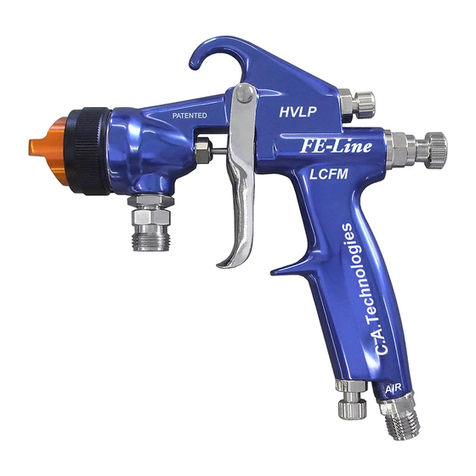
C.A. Technologies
C.A. Technologies FE-Line LCFM Operation and maintenance instructions
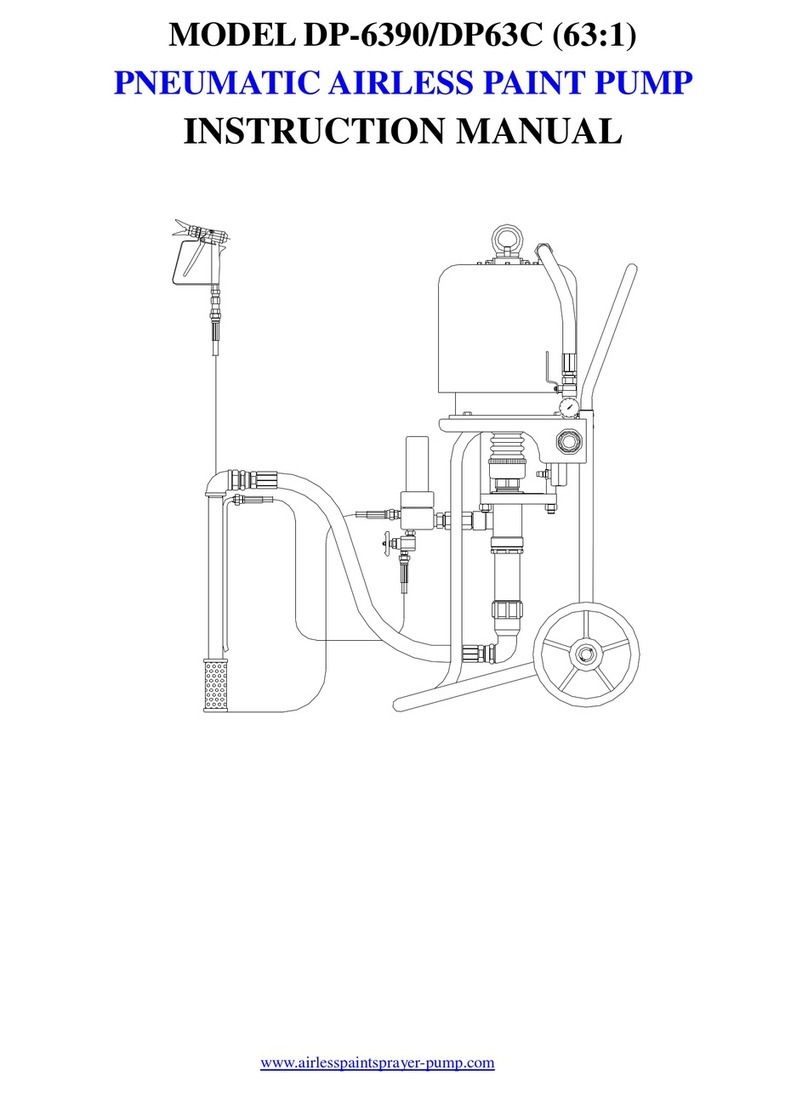
Airless
Airless DP-6390 instruction manual

Chapin
Chapin 97500B Assembly / operation instructions / parts

DeVilbiss
DeVilbiss Finish Line FLG-MGQ-700-FL Service bulletin
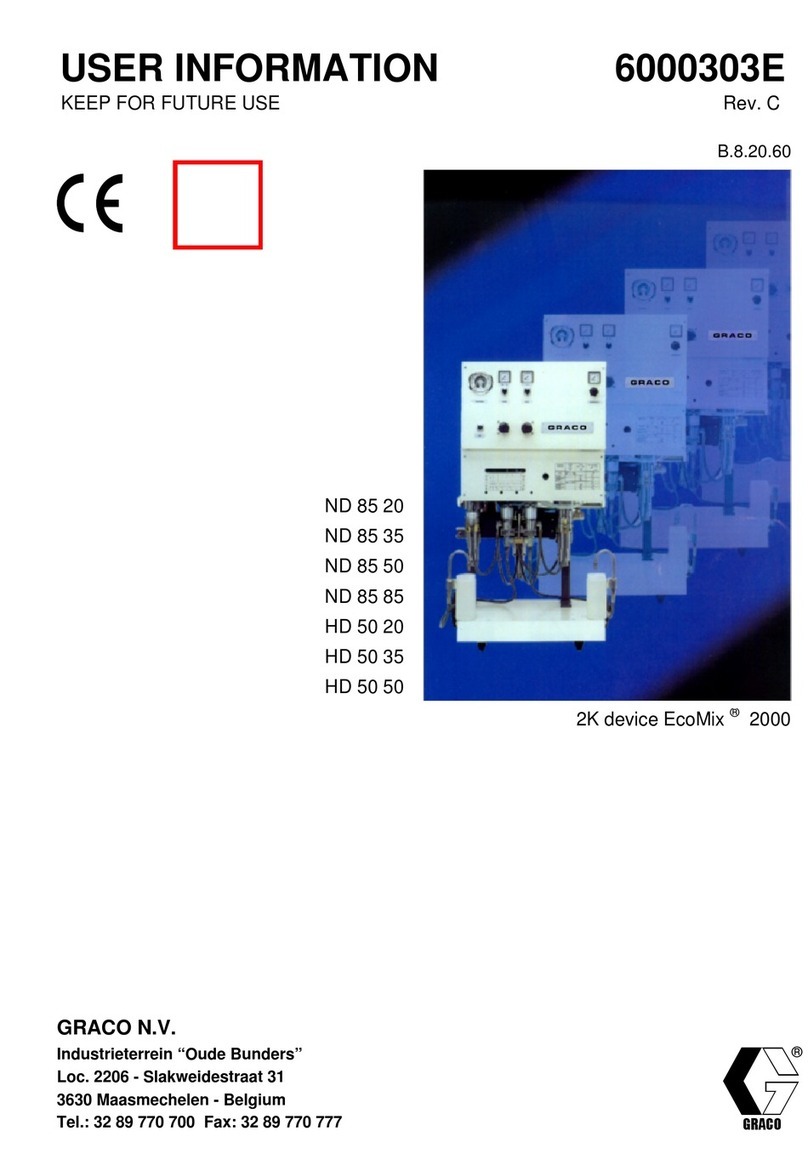
Graco
Graco 2K device EcoMix 2000 User information
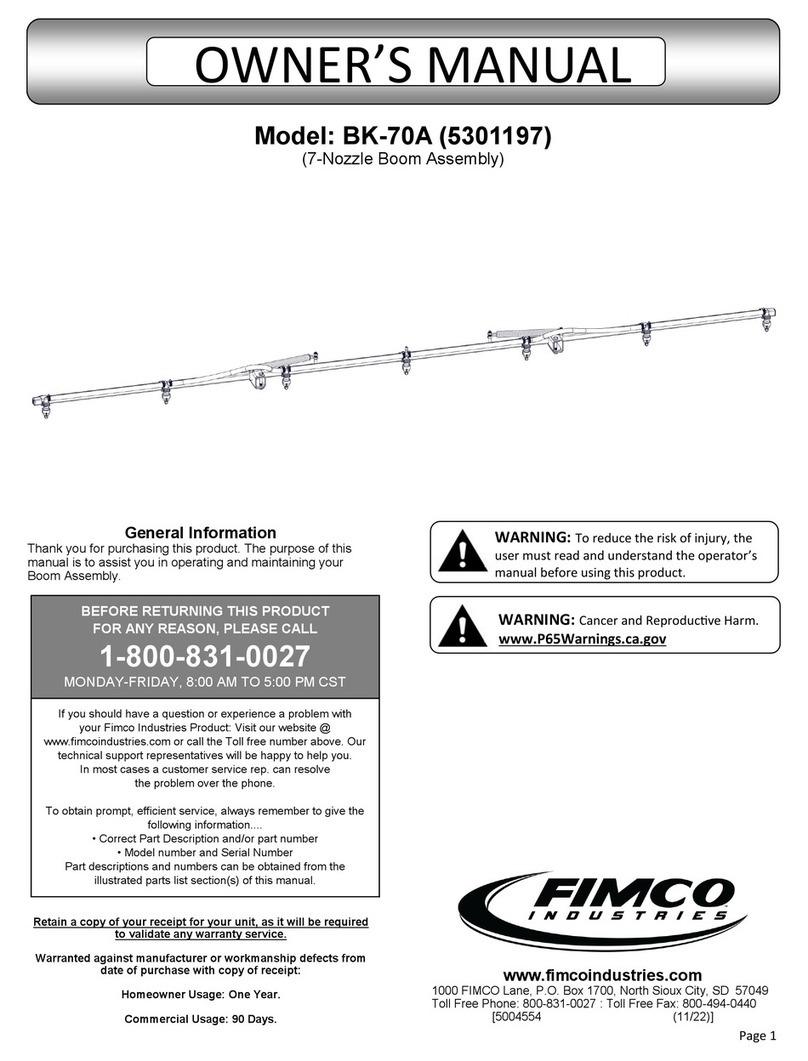
Fimco
Fimco BK-70A owner's manual
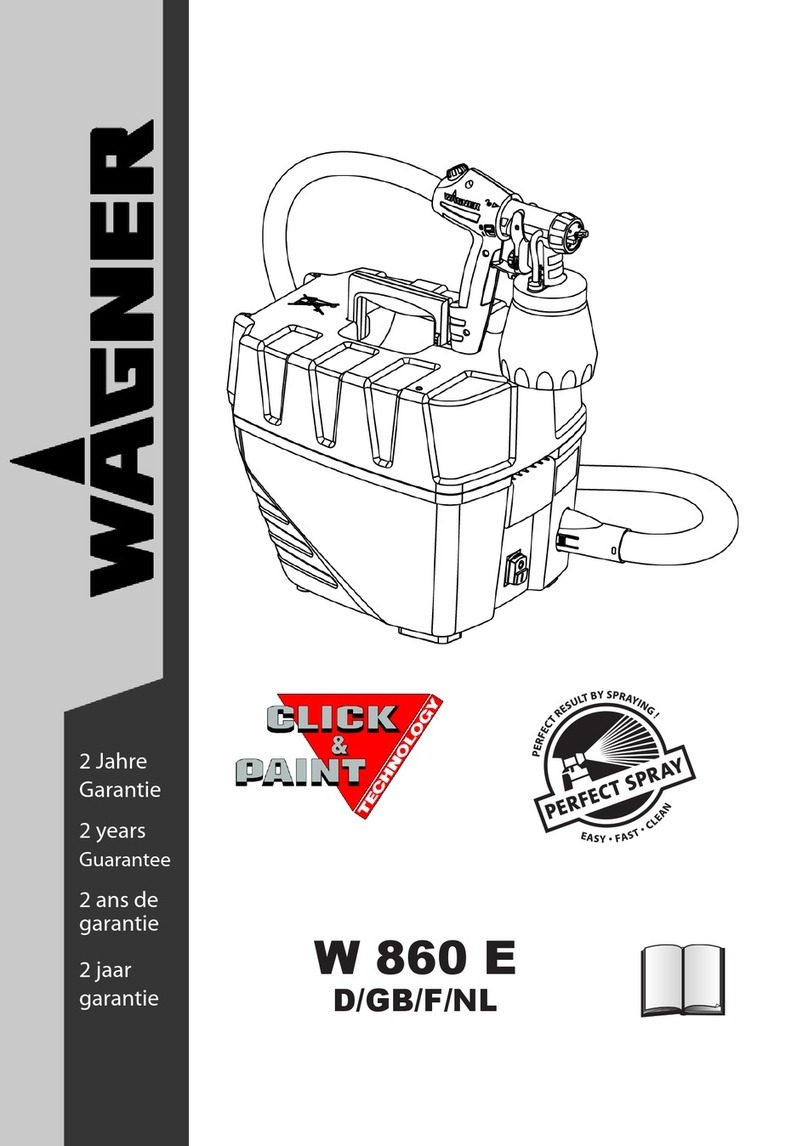
WAGNER
WAGNER W 860 E instructions

Titan
Titan LX-80 Platinum instruction sheet

Bosch
Bosch 2 608 190 048 Original instructions
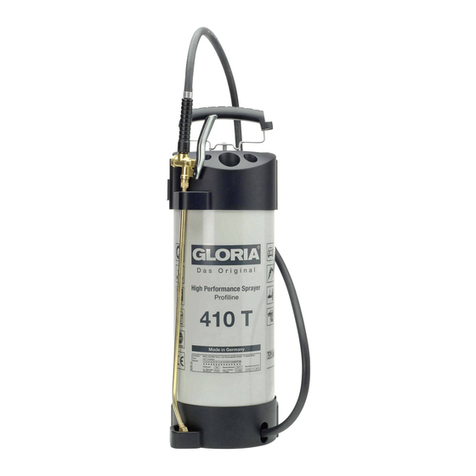
Gloria
Gloria Profiline 410T operating instructions
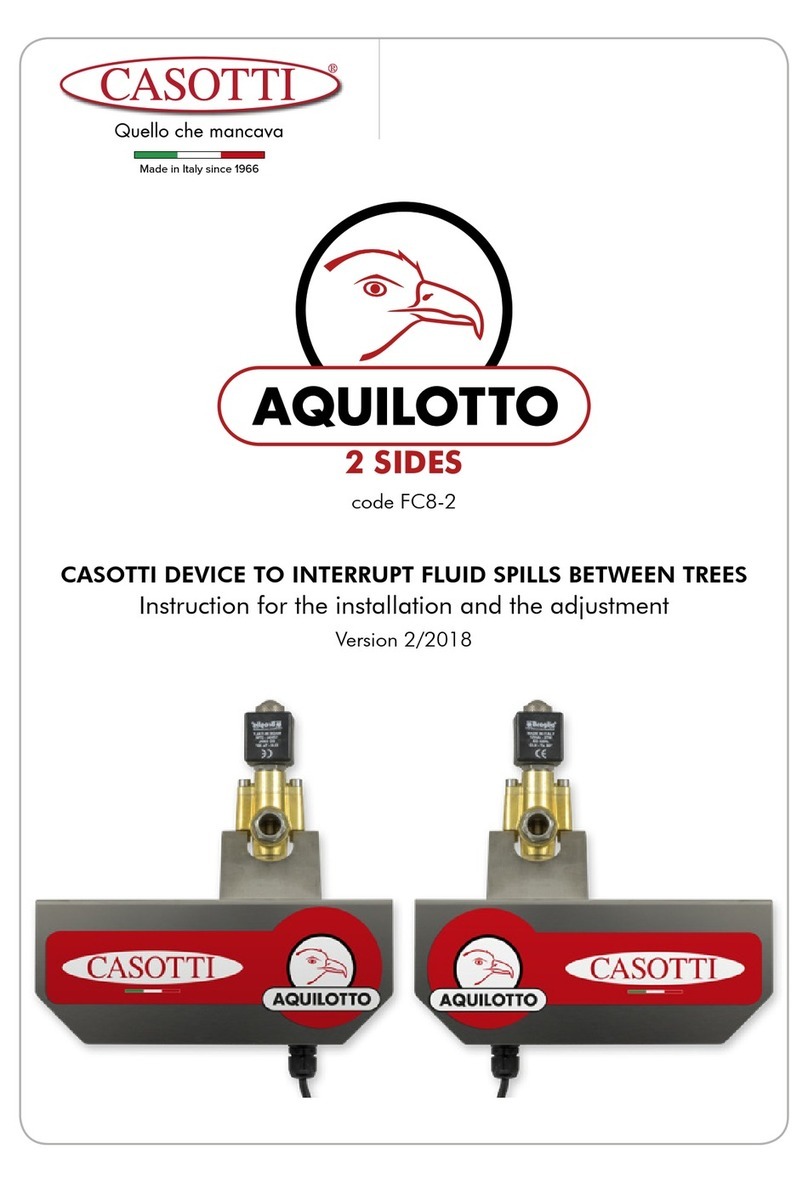
Casotti
Casotti AQUILOTTO FC8-2 Instruction for the installation and the adjustment

Nordson
Nordson Encore HD Customer product manual
